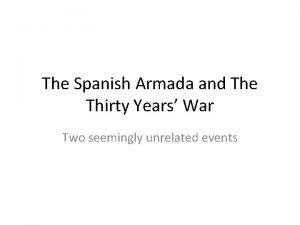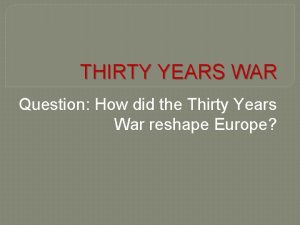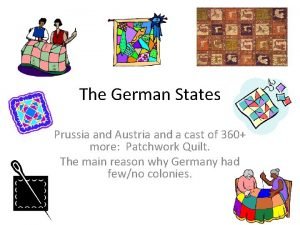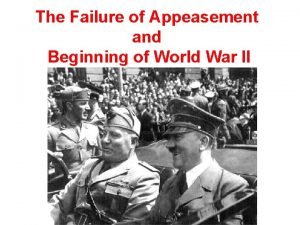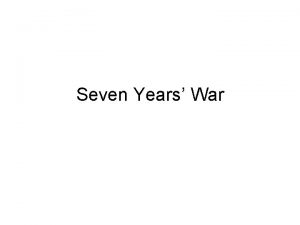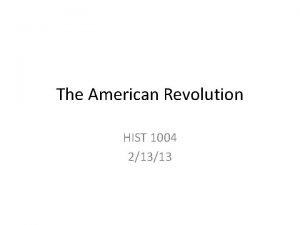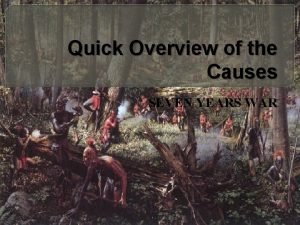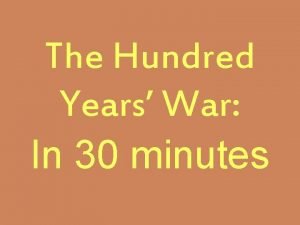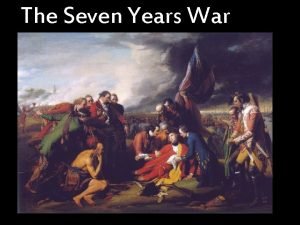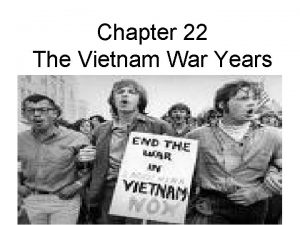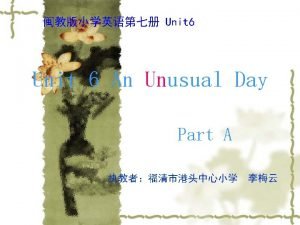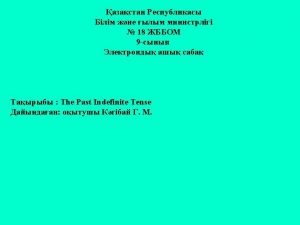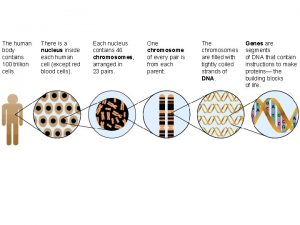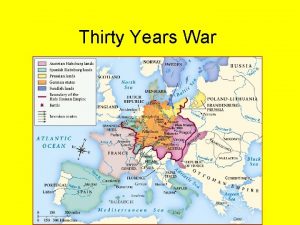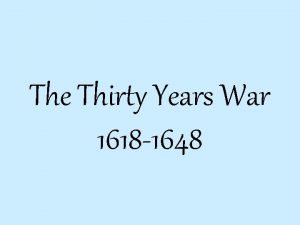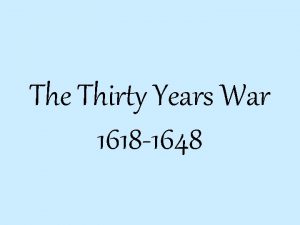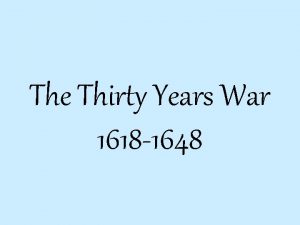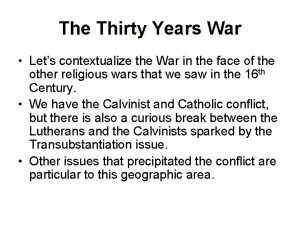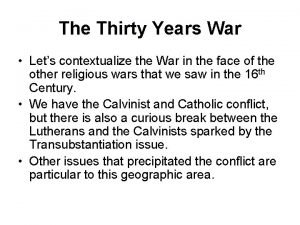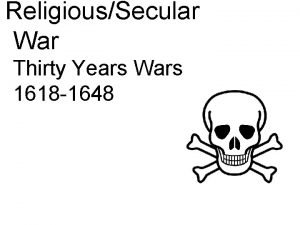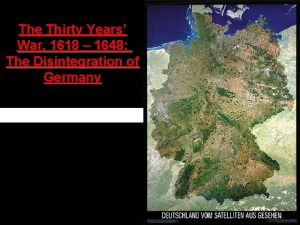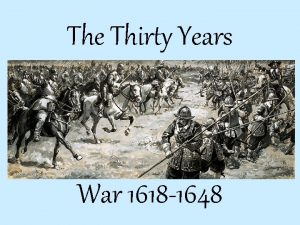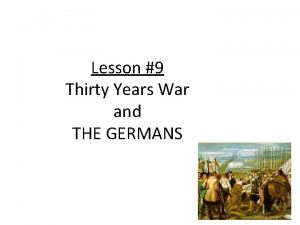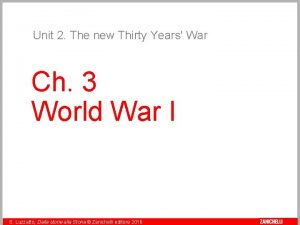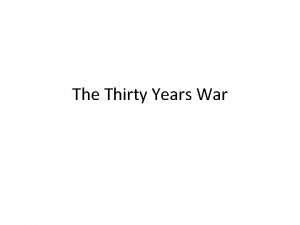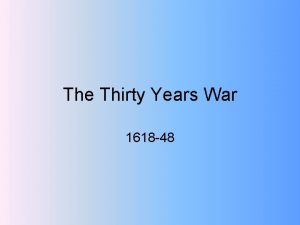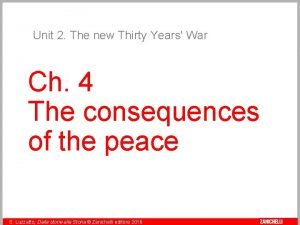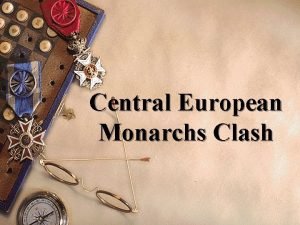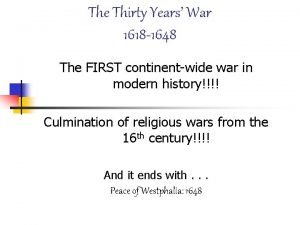War in Germany Lecture 2 The Thirty Years

























































- Slides: 57

War in Germany, Lecture 2: The Thirty Years War

In 1639 the vicar of the Lutheran churches of Calw in Swabia took stock: Of his 1046 communicants in 1630 only 338 remained alive. In the last five years 518 had been killed. 5 of his closest friends, 33 other friends, 20 family members and 41 clerical colleagues. “I have to weep for them” he recorded in his autobiographical notes “because I remain here so impotent and alone. Out of my whole life I am left with scarcely 15 person alive with whom I can claim some trace of friendship. ”


War began with Bohemian rebellion in 1618 and continued until Treaties of Westfalia (Osnabrück and Münster) in 1648 1. The Thirty Years War as German tragedy 2. The Thirty Years War as a triumph of protestant modernity 3. The Thirty Years War as the product of and incubator of a violent and ambiguous modernity

The Holy Roman Empire: conferred on Charlemagne by Pope Leo in 800 Rudolf I first Habsburg Holy Roman Emperor 1273 -1291

Germany is divided by reformation. Twice divided: Lutheranism and then Calvinism. Peace of Augsburg 1555 permits local sovereigns to dictate religion.

Habsburgs based in Vienna routinely elected Emperor Regional princes playing for position – Lutherans in Saxony and Catholics in Bavaria Calvinists in Palatinate with friends and connections in Netherlands and England, both of whom have been in violent conflict with Spanish

… balance is fragile: Catholic counter-reformation is menacing to protestants. Personified by the next Habsburg up as Holy Roman Emperor, the Future Ferdinand II who between 1617 and 1619 inherited the possessions of his childless cousin Matthias. Ferdinand was trained by Jesuits and had suppressed Protestants in his lands, using treaty of Augsburg provisions to the full.

Confessional balance was highly unstable in mixed areas Defenestration at Prague 23 May 1618: Imperial ambassador tossed out of the window by indignant Bohemian protestants


The Calvinist axis of the early war Palatinate linked to Netherlands and Puritans in England Apart from trouble at the top (1) and rebellion from below (2), third factor in the mix is outside intervention.

Narrative 1 German civil war protracted and turned to national martyrdom by foreign Intervention Act 1: Calvinist Rebellion v. Catholic Habsburgs 1618 -1622

Protestant rebels: Frederick V of Palatinate/Bohemia and his English wife Elizabeth Stuart are chosen to become new king and queen of rebel Bohemia Johann Tserclaes, Count of Tilly 1559 -1632 zealous Jesuit-trained, monk in armor, victorious commander of Catholic League armies 1616 -1632

7 -8 November 1620 Battle of White Mountain, near Prague – Pieter Snayers There were 11, 000 -foot soldiers, 10, 000 cavalry, and 10 cannon on the Protestant side. The Imperial army numbered 23, 000 in total with 12 cannons

Act 2: Danish Lutheran intervention 1625 -1629 Fiasco of the Bohemian-Palatinate Protestant rebellion intervention by the Lutheran monarchy of Denmark. Albrecht von Wallenstein (1583 -1634): son of Bohemian protestant gentry calls for Vienna to create its own massive imperial army to lead war rather than Tilly and the Catholic League. 1625 -1630 Catholic/Imperial forces invade Northern protestant Germany to drive the Danes out. But fear of Wallenstein’s personal ambition and shifting power balance in Holy Roman Empire towards Vienna Wallenstein deposed following the meeting of the electors of the Holy Roman Empire in summer of 1630

Act 3 Gustavus Adolphus, the Protestant Savior Arrives in Pomerania June 1630


The Lion of the North at Breitenfeld, 17 Sep 1631 The largest and bloodiest battle of the war: 25, 000 Swedes and 18300 Saxons v. Tilly’s Imperial and League army of 32, 000 destruction of Tilly’s army


So desperate did the situation of the Catholic League and the Empire become that Wallenstein is recalled hit and run campaign between Gustavus Adolphus and Wallenstein 1631 -1632

16 November 1632 Gustavus Adolphus killed in defeat at Battle of Lützen


The Swedes consolidated their position in Northern Germany. Wallenstein could not pay his armies. he is in favor of peace before the French intervene. His independence is resented and talk of peace is seen as treason. 25 February 1634 Wallenstein former Imperial commander in chief assassinated.

6 September 1634 Imperials win a great victory at Nördlingen tilting balance of power decisively P. MEULEN. . 1635 Capture of Swedish commander Gustav Horn at Nördlingen

Act 4 1636 -1648 French intervention Cardinal Richelieu (1585 -1642): the architect of France‘s non-confessional, realist anti-Habsburg intervention in the Thirty Years War

Battle of Rocroi: French army finally prevails against Spanish army of the Netherlands 19 May 1643 – last stand for the famous Spanish spear formation the tercio

With Habsburg armies pressed on all sides, the war ends where it began the Swedish siege of Prague 1648

Germany is Europe’s victim = image entrenched particularly in 19 th century historiography and deeply etched down to the 1930 s. Gustav Freytag’s immensely popular 19 th century history of Germany Günther Franz – Nazi Historian who updated statistical estimates of German losses

But it clearly isn’t a German drama only ‘Protestantism struggled for life alike in Germany and in New England … With the constitution of Plymouth, which was signed in Cape Cod habor, it triumphed in New England in the same month (November 1620) in which it was struck down on the White Mountain in Bohemia. … The day Winthrop sailed into Boston harbor (June 1630), Gustavus Adolphus was landing fifteen thousand men in Pomerania. The thoughts of Germany and of the new people in America ran together: one and the same element of life animated them all. The congregations of Massachusetts, too feeble to send succor to their European brethren, poured out their soul for them in prayer. ’ George Bancroft, History of the United States (1876)

Narrative 2: Anti-Empire – the Thirty Years War as the Triumph of Protestant Pluralistic Modernity – China avoided

One hundred years earlier Charles V hits the dynastic jackpot Unified “reconquered” catholic Spain Holy Roman Empire

The price of all those dynastic lineages …. ? Or anti Habsburg propaganda?

Charles V in his pomp, the universal monarch


Henry VIII of England submits to Charles V and Pope Leo He was married to Charles’s sister and Henry’s daughter Mary married his son Phillip.

“the Empire on which the sun never sets”

Countervailing tendency 1: Habsburgs v. France v. Ottomans 16 th century

Enemies of Habsburg Empire: Francois I of France and Suleiman the Magnificient c. 1530

Countervailing tendency 2: Charles V and the Pope confront Martin Luther at Diet of Worms c. 4 pm 18 April 1521: “Here I stand for I can do no other”

Worms: another view Charles V “closely” following the “argument between monks”

Dutch revolt 1568 -1648: centrifugal force 3 – capitalism Dutch naval power crushing Spanish galleys 1602 Dutch army of the 1580 s is the first to give priority to firearms

“The Lion of the North” and champion of protestant modernity: Gustavus Adolphus at Breitenfeld September 1631 crushing the Jesuit Tilly

West Point Military History Museum’s rendition of Breitenfeld with commentary: “Some 300 years later, during the Thirty Years was, the Swedish King Gustavus Alolphus soundly defeated the Imperial Catholic Army commanded by Count Tilly at the Battle of Breitenfeld in 1631. Gustavus employed a modern combined arms approach to warfare, making greater use of mobile light artillery working in close support of swift-firing musketeers and hard-hitting cavalry columns. Against the more static, densely-packed masses of Tilly's pikemen and smaller number of musketeers, Gustavus' tactics proved highly successful. ”

Empire = stagnation a la chinoise Pluralistic competition is the “killer app” of western civ It’s a secularized version of a story that once went like this …

Lineage of Protestant warrior heroes: William of Orange (1533 -1584), Gustavus Adolphus (1594 -1632), Oliver Cromwell (1599 -1658) paves the way for …

China und Ming 1388 -1644 And Qing 1644 -1912 dynasties became the image of long-run stagnation at high level of sophistication Source: Voigtländer, Nico, and Hans-Joachim Voth. "The three horsemen of riches: Plague, war, and urbanization in early modern Europe. " Review of Economic Studies 80. 2 (2012): 774 -811. Economic historians will turn even spectacular mortality into a bonus!

Narrative 3 The Thirty Years War as the opening to a catastrophic modernity

Parker, Geoffrey. "Crisis and catastrophe: The global crisis of the seventeenth century reconsidered. " The American Historical Review 113. 4 (2008): 1053 -1079.

Reformation and counterreformation ideological escalation Protestant propaganda massively exaggerates scale of Catholic threat in the early 1600 s. War starts as a clash between radicalized minorities. Crudely put crusading Calvinists and crusading Jesuits.

Ideological polarization is compounded by a media revolution: First newspaper was the dutch/protestant Nieuwe Tijdinghe appearing in 1605 in Antwerp

1. Fanaticism and Propaganda The Sack of Magdeburg May 1631 News of Sack of Magdeburg on 20 May 1631 reached Leipzig on 22 nd May, Hamburg 25 th May and Vienna by courier on 26 May 205 pamphlets and 41 leaflets in 1631 alone

Sack and plunder were in fact legally regulated. - Brandschatzung Cities that capitulated formally were not to be sacked. If it did not surrender it risked annihilation. Tilly was driven to do it in part by the difficulty of paying and feeding his troops. Means of war-fighting escalated Feudal levies of knights and peasants Mercenary troops on the condotteri system that emerged in Italy in 15 th and 16 th century Standing armies mobilized by richest states – Spain and Netherlands in 1500 s Wallenstein’s giant Imperial army after 1625 counted 150, 000 plus.

New model armies inspire visions of expansive ambitious warfare modernist overreach Gustavus Adolphus with 20 -30, 000 men imagines capturing Vienna. In fact, you can win battles but not occupy territory or decide the war. Thirty Years War is a bit like WWI

Armies are staggeringly expensive. Best estimate of European per capita income in modern dollars in the 1600 s is c. 600 -800 dollars per head person life expectancy c. 40

Inability to finance in stable form through taxation inflationary pressure: Prices in Dresden (Saxony) Scheffel of Wheat in 1600 2 thaler 15 groschen by 1622 11 thaler 5 groschen Wallenstein was not just a politician and warlord, he was the ultimate war profiteer with a mint lease for much of Habsburg empire.

Thirty Years War as a case of “state failure” As Thomas Hobbes was to put it in his Leviathan in 1651, summing up the wisdom of the last generations: Whatsoever therefore is consequent to a time of Warre, where every man is Enemy to every man; the same is consequent to the time, wherein men live without other security, than what their own strength, and their own invention shall furnish them withall. In such condition, there is no place for Industry; because the fruit thereof is uncertain; and consequently no Culture of the Earth; no Navigation, nor use of the commodities that may be imported by Sea; no commodious Building; no Instruments of moving, and removing such things as require much force; no Knowledge of the face of the Earth; no account of Time; no Arts; no Letters; no Society; and which is worst of all, continuall feare, and danger of violent death; And the life of man, solitary, poore, nasty, brutish, and short. "

Ambiguous political legacy of the war Response 1: make a state to impose order Response 2: the search for a liberal peace Response 3: the search for victory even at price of apocalyptic battle
 Hapsburgs
Hapsburgs Thirty years' war causes
Thirty years' war causes Prussia
Prussia Britain and france declared war on germany
Britain and france declared war on germany Four score and seven years ago
Four score and seven years ago Sheep years to human years
Sheep years to human years 300 solar years to lunar years
300 solar years to lunar years 01:640:244 lecture notes - lecture 15: plat, idah, farad
01:640:244 lecture notes - lecture 15: plat, idah, farad 1453-1337
1453-1337 Causes of seven years war
Causes of seven years war Seven years war
Seven years war 7 years war apush
7 years war apush What caused the seven years war
What caused the seven years war Consequences of the 100 years war
Consequences of the 100 years war What caused the seven years war
What caused the seven years war The domino theory vietnam war
The domino theory vietnam war 30 years war phases
30 years war phases I slip i slide i gloom i glance
I slip i slide i gloom i glance Ones tens hundreds
Ones tens hundreds You often get up at six thirty
You often get up at six thirty The thirty three thieves
The thirty three thieves Thirty trillion cells eleven systems
Thirty trillion cells eleven systems It's twenty-five to three
It's twenty-five to three It's ten twenty
It's ten twenty Chapter 30 the war to end war
Chapter 30 the war to end war Description
Description Perfect lizz
Perfect lizz Ich war du
Ich war du Chapter 30 the war to end war
Chapter 30 the war to end war The cold war lesson 1
The cold war lesson 1 Toward civil war lesson 3 secession and war
Toward civil war lesson 3 secession and war Reconstruction venn diagram
Reconstruction venn diagram Tug of war or tug-of-war
Tug of war or tug-of-war Proxy wars in cold war
Proxy wars in cold war War at home and abroad madison
War at home and abroad madison Was josette dugas pro war
Was josette dugas pro war Why was the civil war considered the first modern war
Why was the civil war considered the first modern war Phối cảnh
Phối cảnh đặc điểm cơ thể của người tối cổ
đặc điểm cơ thể của người tối cổ Các châu lục và đại dương trên thế giới
Các châu lục và đại dương trên thế giới Chụp phim tư thế worms-breton
Chụp phim tư thế worms-breton Thế nào là hệ số cao nhất
Thế nào là hệ số cao nhất Hệ hô hấp
Hệ hô hấp ưu thế lai là gì
ưu thế lai là gì Tư thế ngồi viết
Tư thế ngồi viết Bàn tay mà dây bẩn
Bàn tay mà dây bẩn Mật thư tọa độ 5x5
Mật thư tọa độ 5x5 Bổ thể
Bổ thể Tư thế ngồi viết
Tư thế ngồi viết Thẻ vin
Thẻ vin Thể thơ truyền thống
Thể thơ truyền thống Chúa yêu trần thế alleluia
Chúa yêu trần thế alleluia Các châu lục và đại dương trên thế giới
Các châu lục và đại dương trên thế giới Từ ngữ thể hiện lòng nhân hậu
Từ ngữ thể hiện lòng nhân hậu Khi nào hổ mẹ dạy hổ con săn mồi
Khi nào hổ mẹ dạy hổ con săn mồi Diễn thế sinh thái là
Diễn thế sinh thái là Vẽ hình chiếu vuông góc của vật thể sau
Vẽ hình chiếu vuông góc của vật thể sau Ví dụ về giọng cùng tên
Ví dụ về giọng cùng tên
